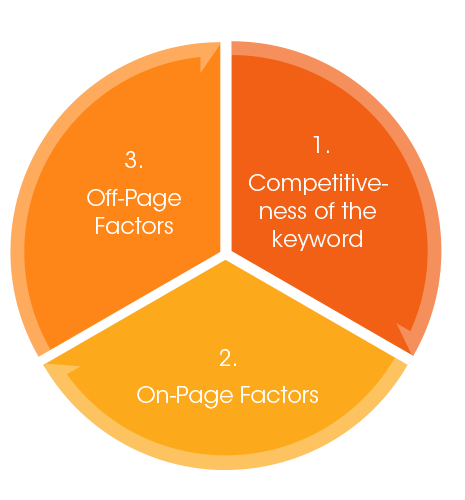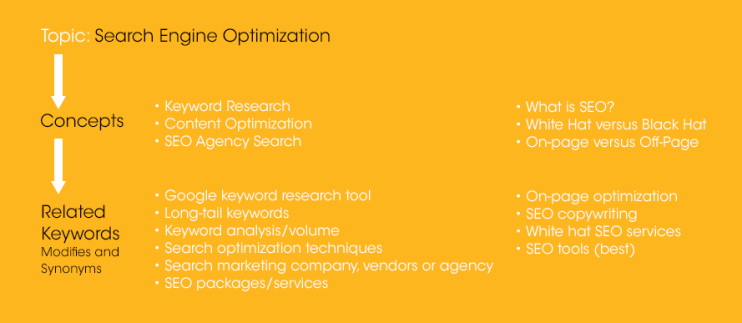Everything we do in SEO starts with Smart Keyword Selection | Your Guide to Modern SEO

Words matter. Especially keywords.
Everything comes down to the words buyers use in Google whether typed into the browser, using voice dictation, spoken into devices like Amazon Echo, Google Home or in Apple’s Siri.
What we’re up against…
Over one billion websites. 60 trillion pages. And growing every day.
There are more than 10 million Google search results for the phrase “keyword research“. Our goal with search engine optimization is to influence the position and engagement that a web page receives for a keyword search (AKA “search query”).
3 Factors Impacting Search Engine Visibility
Three factors have a dynamic relationship on page ranking and it varies depending on the keyword phrase.

- Competitiveness of the keyword: Ranking competition varies depending on the popularity of the keyword phrase. The more competitive a keyword, the more difficult it will be to rank.
- On-Page Factors: Page content and topic, link text, site structure and user engagement from Google. Think of user engagement this way: If a search visitor clicks on your link and immediately bounces back to Google, they’ve sent a strong signal to Google that your page wasn’t a good result.
- Off-Page Factors: Quantity of inbound links pointing to the web page and social signals such as authorship & viewership. Think of Off-Page factors as “TRUST”, “AUTHORITY”, relevancy and credibility.
→ Download: The Quick Start SEO Guide for Content Creators.
It’s Much Harder to Rank in 2020 with Semantic Search
For years now, Google has been able to understand what a web page is about so that it can map search results to user intent. We call this approach “semantic search”. Here’s how it works.
BEFORE: How do I rank for this keyword?
NOW: How best do I answer my prospect’s question?
Google aims to offer the most relevant results for a search query. It determines ranking position by evaluating how well your content answers the searcher’s question. Google is looking for signals that suggest the author is an AUTHORITY on the topic.
Semantic Search Example
Try this example to see how semantic search works.
STEP #1)
- Google the phrase: Who is the wealthiest person in the world?
STEP #2)
- Review the search results. The top results indicate that Google understood that by searching for “wealthiest person” in the world, you were looking for current data or a list indicating the wealthiest people in the world. Google returned the result you wanted, even though your exact phrase may not have appeared on the top search results.
- Who Was Ranked in Position One and Why? The pages returned are from sites that are deemed to be an authority on the topic. For example, Time.com produces this same list every year and they are a ‘trusted source’.

Keyword Selection: How Do You Find the Right Keywords?
#1) Start by analyzing the keywords visitors are using now to find your site.
Google Search Console (GSC) – Google’s dashboard for webmasters – offers this data for free in 90-day chunks. Here’s how to start once you have sufficient data in GSC.
- From within GSC, select Search Traffic > Search Analytics from left rail.
- Turn on Clicks, Impressions, CTR and Position – then select Queries
- Set date range to 90 days (longest time period available before data disappears)
- Sort columns to show the highest number of impressions for which all your pages are being displayed in response to any search query.
- Begin analyzing the keywords that are and are not getting clicks.
- Focus on important keywords that rank on pages 2, 3 and 4 in Google. It is easier to move those rankings up and see an impact in traffic than if you worked on keywords where you currently rank on page 50, 60 or 100.

 You can also select Pages (instead of Queries) from within this interface. Click through on a top page and then select Queries. If Google has sufficient search query data for your URL, you will see the queries that drove impressions and/or clicks on that page.
You can also select Pages (instead of Queries) from within this interface. Click through on a top page and then select Queries. If Google has sufficient search query data for your URL, you will see the queries that drove impressions and/or clicks on that page.
This is a great place to start with on-page optimization.
#2) Identify similar keywords and concepts and their search volume.
Keyword research is about finding the right keywords – the same words that your customers will use in a Google search.
Start by selecting keywords based on:
- Language your customers use: words buyers talk about when describing a problem.
- User intent: are visitors likely to convert if they visit your content using this search query?
- Topical relevance: find keywords associated with your topic that typically co-exist on top-ranking pages.
- Search volume and competition: do buyers type or speak these words in Google?
- Related phrases: to avoid keyword stuffing, identify variations and synonyms for your keywords. This will also help your content be found for a wider array of long-tail keywords.
Keyword Research Tools
There is no tool that provides 100% data accuracy.
There are hundreds of keyword tools, but the data provided in these tools should only be used to uncover relevant keyword ideas. aHref likely provides the best keyword volume data because of the size of its database.
- Google AdWords Keyword Planner (free) (provides unreliable search data for SEO purposes)
- Google Search Console (free)
- Google Trends and Google Suggest (appears on search results page)
- aHref’s Keyword Explorer (Paid w/ free trial)
- Moz Keyword Explorer (Paid)
- Long-Tail & Modifiers: Übersuggest (don’t forget to run on competitor pages)
- Word Clouds: TagCrowd.com / VisualThesaurus.com
- See What GoogleBot Sees – Identify On-Page Keyword Use: ToTheWeb Google Search Engine Spider Simulator
- Thesaurus and Synonyms Libraries. Use to identify similar keywords and concepts.
Searchers are getting far more sophisticated and are using full sentences and questions as part of their search query.
What is the Process to Identify and Organize Your Best Keywords?
Now that you have discovered hundreds and hundreds of keywords, it’s time to refine and organize your list.
Think: buyer’s journey and buyer pain points. Download the in-depth Guide to Keyword Research and Content Optimization

- Organize keywords into high-level TOPICS around the services your company provides.
- Find related CONCEPTS or THEMES that map to customer questions.
- Individually analyze the pages that rank on page one for your topics.
- The amount of content on a page often determines the number of concepts and keywords you can naturally include.
- Select keywords that have the highest relevancy and buyer intent and that receive a reasonably high number of monthly searches. (relative to all other keywords).
- Identify keywords that are closely related and their modifiers.
- Organize in Excel – download our Example Keyword Research File
 If you use ScreamingFrog to analyze search optimization efforts, it is helpful to insert your important keywords that a page is optimized for in the Keyword Meta Tag. That when Screaming Frog crawls the site, you can instantly see the keywords you are targeting. The Keyword Meta Tag does NOT have any impact on search rankings.
If you use ScreamingFrog to analyze search optimization efforts, it is helpful to insert your important keywords that a page is optimized for in the Keyword Meta Tag. That when Screaming Frog crawls the site, you can instantly see the keywords you are targeting. The Keyword Meta Tag does NOT have any impact on search rankings.
Think about TOPICS and CONCEPTS and Map to Your Services

aHref analyzed 1.4 billion Google searches and here’s what they found…
- One and two-word keywords account for only 13.6% of searches
- 96.54% of search queries in the US have less than 50 searches per month
- 40% of ALL searches are coming from keywords that have less than 50 searches per month
When Should You Start Keyword Research in a Website Relaunch Project?

Know before you go! Keyword Selection Fundamentals
- Low-volume keywords: There is little value in ranking on page 1 in Google for a keyword no one is searching for
- Impossibly high-volume keywords (broad 1-2 word phrases) are too popular to rely on to improve search ranking and lead generation. Long-tail “high-intent” keywords have less competition and accelerate lead generation.
- Keyword localization: Google knows that “color” and “colour” are different spellings based on localization of content for the same word. Adapt spelling for your geographic region. This includes misspellings too!
- Punctuation? Irrelevant… Google ignores punctuation and capitalization. That means it sees “Pay-Per-Click” as the same word as “pay per click”. It knows “e-mail” is the same as “email”.
- Marketing jargon – an SEO no-no. Keywords such as “best of breed” or “mission critical” hinder effective on-page optimization. Use the keywords that prospects would use in normal conversation. Speak in the buyer’s language.
- Unnecessary Keywords: Including both spellings of a word can be awkward and unnecessary. Example: Mega menus and “megamenus” – Google knows they are the same. Just use one, consistently.
- Stop words in keyword phrases. Search engines ignore common words such as “and,” “to,” “the.” “Optimize your PDFs” is the same as “Optimize PDFs” 8
- Google will rank a page for search queries that are not on the page. For example, this short page receives impressions for a total 999 keywords. Of those impressions, the page receives clicks from 366 unique keywords – the majority of which are not found on the page.
→ Download: Every PDF deserves a GREAT title.
KEYWORD RESEARCH WRAP-UP
Google understands searcher’s intent. Increase conversions by mapping keywords to what visitors are looking for. Focus on industry-specific keywords. Use synonyms and variations of your primary keyword. Add long-tail modifiers to expand search opportunity.
✔ Click here to get the Keyword Guide Excel Template
✔ Use our SEO Content Template to simplify the SEO implementation process.
✔ Download our Keyword Optimization Guide to learn the basics.
✔ Download: Introducing Intelligent Keyword Selection
Rosemary Brisco
AI Training Videos
AI Consulting and Training
Master today’s most effective productivity tools.
ToTheWeb ensures your route to capitalizing on the immense power of AI is fast and efficient. Our AI consulting and training programs will quickly enable your marketing team to adopt solutions to optimize operations and boost performance.
Learn about our generative AI and ChatGPT consulting and training programs



